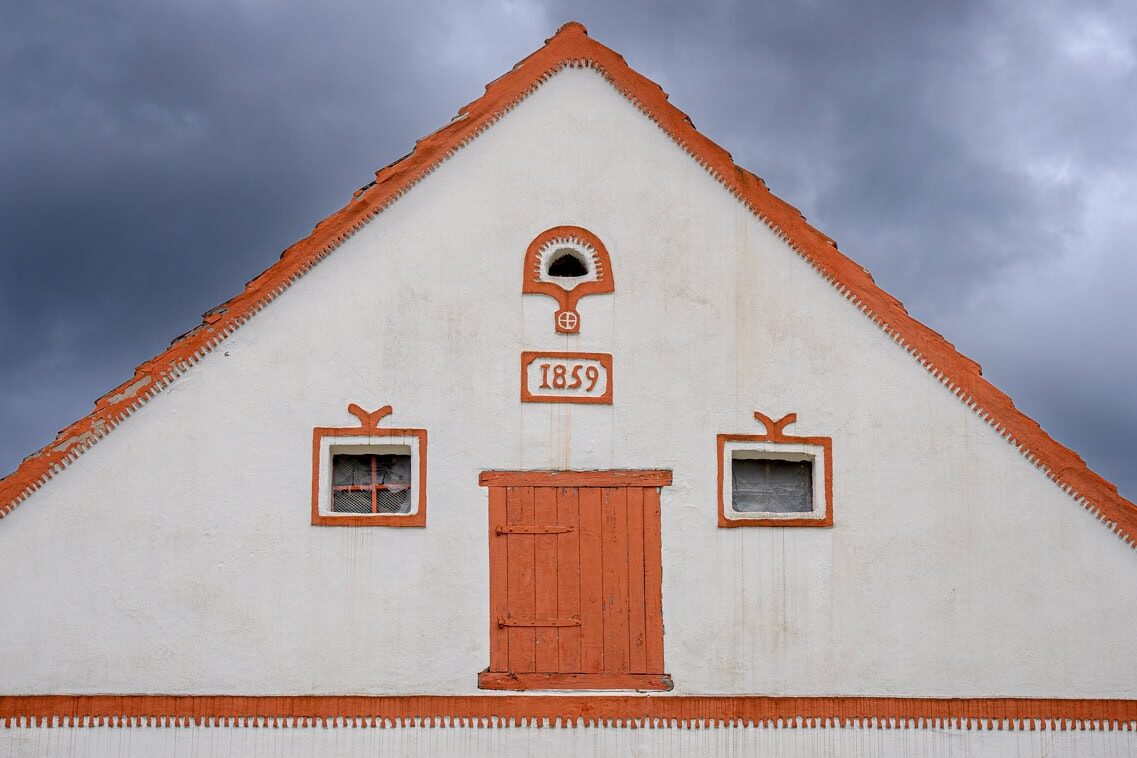So, what is this Holasovice? Jin asked a few times as we drove along the narrow country roads of South Bohemia. My best answer was: It’s a tiny, beautiful UNESCO village, one of the prettiest in the Czech Republic.
When we plotted our Bohemian road trip, we knew we wanted to visit some of the Czech Republic’s hidden gems, and when I saw photos of Holasovice, I knew we had to make a stop there.
So there we were, following Google Maps towards Holasovice, cruising along empty country roads that were becoming narrower and narrower. The drive alone was worth coming out this way. It’s a rural part of the country that’s a world away from the masses that flock to Prague and nearby Cesky Krumlov.
With each kilometre, our anticipation built, not knowing exactly what to expect from Holasovice. When we arrived at the village’s empty parking lot, Jin’s question echoed in my mind, and I wondered if it was perhaps a mistake to have made this detour instead of heading straight to Cesky Krumlov.
But as we walked around the corner into the village, we both agreed that, yes, it was so worth it.
If you’re looking for a pretty, pint-sized village to visit in the Czech Republic, you should be like us and visit Halosovice. Let’s show you why.
Thank you to VisitCzechia for hosting us in South Bohemia. As always, the love for a good farm village and opinions are our own.



Please note: This post may contain affiliate links. This means I may earn a commission if you make a purchase by clicking a link (at no extra cost to you).
Quick Guide to Holasovice Village
Getting to Holasovice: Renting a car is by far the best way to reach Holasovice. We always use Discover Cars and recommend them for the best rates. We came from Karlovy Vary, which took about 4 hours, with a few stops along the way. Continuing on to Cesky Krumlov was just a 30-minute drive. If you have your own wheels, it will be a very nice side trip from Cesky Krumlov. From Prague, it’s 164 km, which should take roughly two hours.
Buses run roughly every hour from 5 am to 10 pm between Cesky Budejovice Bus Terminal and Holasovice. The Cesky Budejovice bus will take at least 40 minutes ( up to 1.5 hours). Here is the bus timetable.
Holasovice-Cesky Krumlov buses require a transfer and take at least 1.5 hours.
How much time: You can see the tiny village in under an hour.
Parking: Paid parking (50 CZK per hour) is available at the entrance of the village
Our Visit to Holasovice

Our drive from Karlovy Vary took longer than we had planned – there were just so many photo stops along the way.
When we finally get out of the car at Holasovice on 29 December, it’s late afternoon. The car park is deserted, as is the entire village. The Czechs are still on their Christmas holidays, so the residents are inside their homes, and if there were any visitors, they have moved on already. We have the entire village to ourselves.
With the sun setting fast, we walk along the road that runs along the horseshoe-shaped village. Even after taking photos from every angle and enjoying the picturesque architecture of the village, we are done in an hour.
We loved the quiet atmosphere and beautiful farmhouses. Knowing that Holasovice is a real village and not an open-air museum set up exclusively for tourists makes for a nice overall experience, even though we did not see any of the people living there. I guess those who love buzzwords would describe a visit to Holasovice as an authentic experience.
So, What is Holasovice?

Holasovice is a small village consisting of 23 farmsteads with only 140 inhabitants in the South Bohemian Region of the Czech Republic. This beautiful village, its layout unchanged since the Middle Ages, is 17 km west of Ceske Budejovice and 24 km north of Cesky Krumlov. It is an exceptional and well-preserved example of a traditional Central European village and is famous for its unique collection of buildings.
But not just any buildings. These are prime examples of the South Bohemian Folk Baroque architectural style.
This style emerged in the late 18th and early 19th centuries, particularly flourishing after the plague had depopulated much of the region in the preceding centuries. As the area recovered, a distinctive form of Baroque architecture began to take root in the rural landscape.


The village layout is simple yet striking. At its heart lies a large, rectangular village green, a common feature in rural settlements but unique due to the surrounding buildings.
Holasovice is old—it was first mentioned in 1263. The plague left it deserted in the 16th century when only two inhabitants survived. A century later, it was revived when Austrians and Bavarians resettled it. This revival gave birth to the village’s distinctive look today.
The village was abandoned during WW11 and fell into disrepair during the Communist regime. Luckily, Czech people started moving back and renovating Holasovice in 1990.
The buildings, with their gabled fronts facing the green, are unlike anything we’ve seen in the Czech Republic.
South Bohemian Folk Baroque Architecture

The South Bohemian Folk Baroque style features decorative facades and intricate gable designs. Its blend of high Baroque elements with traditional rural architectural features sets this style apart from the over-the-top Baroque we were familiar with.




Holasovice’s buildings stand out with their bright colours, stucco decorations depicting floral and figurative motifs, and facades arranged symmetrically around a central village green.
This layout creates a cohesive and visually appealing ensemble that reflects both the aesthetic tastes of the time and the functional needs of a rural community.
UNESCO World Heritage Status

Holasovice was inscribed on the UNESCO World Heritage List in 1998. The village earned this distinguished status for several reasons:
Exceptional Preservation: Holasovice is an extraordinarily well-preserved example of a traditional Central European village. Its layout and architecture have remained virtually unchanged since the 19th century.
Cultural Significance: Holasovice is an exceptional rural village that reflects the social and cultural traditions of rural populations in Europe. The village’s architectural style showcases its inhabitants’ craftsmanship and aesthetic sensibilities, reflecting broader cultural and historical trends in rural Central Europe.
Architectural Uniqueness: The South Bohemian Folk Baroque style in Holasovice is unique to this region. The village’s buildings showcase a distinctive blend of architectural styles, merging local traditions with Baroque influences to create a unique cultural expression.


Educational Value: Holašovice is an important educational resource for understanding Central Europe’s rural life, architectural evolution, and cultural history. Its preservation allows for ongoing study and appreciation of these themes.
The UNESCO designation has helped to protect Holašovice and ensure the conservation of its architectural heritage and cultural legacy. It draws attention to the importance of preserving such unique rural environments in the face of modernization and development pressures. Holašovice offers visitors a rare opportunity to step back in time and experience the beauty and tranquillity of a bygone era, making it a precious jewel in the crown of European cultural heritage.
Is Holasovice Worth Visiting?

We are glad we included Holasovice on our Czech itinerary. It’s a beautiful small village where (cliche alert) time seemingly stood still without the hordes.
Yes, it is small—tiny, in fact. You won’t find 25 things to do or places to see in Halosovice, but that’s why we like it.
Visiting Holasovice gave us an excuse to get off the beaten path and see a beautiful slice of rural Czechia. If you are an architecture enthusiast, have a fetish for UNESCO sites, or are simply in search of peace and beauty, Holašovice promises an unforgettable journey through the heart of South Bohemia.
Remember, travel is not just about the places we visit but the memories we make along the way.
See you in Holašovice!
I’m sure you’ll find Holasovice beautiful, charming and well worth a visit – just like we did. Drop us a message in the comments below if you have any questions or want to chat about South Bohemian Folk Baroque
✌️
